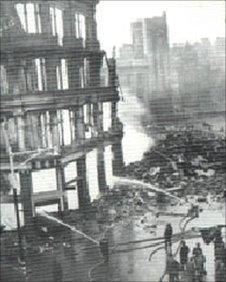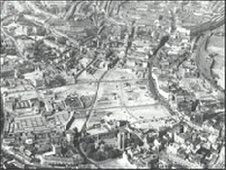Swansea's war - a personal view
- Published

The heart of the city was ripped out by bombing, including the Ben Evans store
I grew up in Swansea, thinking nothing at all of the fact that the geography, economy and psyche of my home had been shaped by events nearly 40 years before my birth.
In the city centre to which I was reluctantly dragged shopping each Saturday morning, none of the architecture matched.
The stunted Tudor saplings of Princess Way, Salubrious Passage and St Mary's Street fought for sunlight amongst Kingsway's monstrous concrete oaks of the 1960s and 70s.
The confidence of Victorian Gothic buildings mingled both incongruously and seamlessly with the utilitarian glass and steel of the Quadrant shopping centre.
At school and university, I studied World War II, and its devastating effects on industrial towns and cities like Swansea.
But it wasn't until I came to write this article, on the 70th anniversary of the first air raids on Wales, that I considered the two experiences as parts of the same whole.
Only now do I realise that for all the books and archives I've read, and lectures I've attended, the very best historical sources had been in my own family.
First raids
My grandparents, Les and Dot Prior lived in Swansea throughout the war, and remember vividly the early hours of 27 June 1940, the night the Luftwaffe flares lit up the sky like day, and bombs fell on Swansea for the first time.
"To be honest with you, up until that night we'd thought it was a lot of fuss about nothing," recalled my grandmother.
"The council had been giving out Anderson Shelters, but there didn't seem much of a rush, and it all seemed like they were getting themselves into a flap like they had about the gas masks.
"When we heard the planes coming over for the first time - a totally different sound to the RAF planes - and saw the holes they left, it brought us all up short."
Despite being identified as a probable German target as early as 1937, efforts to bolster Swansea's defences appeared to lack urgency.
The city's official archive shows that by the outbreak of war in September 1939, just 6,500 of the 30,000 Anderson Shelters needed to protect the inhabitants had been distributed.
As late as the beginning of 1940 councillors were questioning whether Swansea's civil defence plan was an unnecessary burden on the city's ratepayers.
However, after the fall of France and the Dunkirk evacuations, the German bombers could now reach Wales with ease, from captured French airfields.
Daylight attack
As my grandfather, who was in the Home Guard, recalled: "One of the earliest air raids I can remember must have been in the first few weeks after Dunkirk.
"I was on the 'Ack Ack Guns' at about half past 10 in the morning, when a lone French plane flew over.
"The alert didn't go up because of the Allied markings, and because nobody thought the Germans would have dared fly in that low in broad daylight."
"But it was a captured French plane which dropped four bombs on King's Dock and killed quite a few men. I think it was the first time people had been killed in Swansea, and it was then we knew we were in the war."
After the first raid, Swansea came under attack on another 43 occasions.
By the time of the final enemy sortie on 16 February 1943, 384 people were dead and a further 859 were injured.
In total, Swansea came under high alert 524 times, with residents spending an aggregate of 1,537 hours under immediate threat of bombing.
By far the worst attack came during the 'Three Nights Blitz that began on 19 February 1941, when German bombers dropped around a 1,000 high explosives, and between 30 and 50,000 incendiary devices.
Swansea burning
On the first night, high explosives softened the targets, rupturing gas and water mains, making the fire bombs of the following two nights easier to ignite and harder to extinguish.
The landmarks of St Mary's church and the Ben Evans department store in Castle Street were destroyed, and 41-acres of the main commercial district were consumed in one enormous fireball.
Grafton Maggs was a young boy in Mumbles, and saw Swansea burn.
"The Luftwaffe grouped in the bay at about nine, then it all went quiet," he said.
"Eventually you could hear them flying in one after the other.

This old picture shows bomb damage in central Swansea
"The incendiary bombs are the ones which stick in my mind. As they fell over the town it was like the tide coming in on a sea of fire.
"The magnesium would start off burning blue, and as the fires caught they'd mushroom deep red and yellow, hundreds of feet into the sky.
"That was what they could see from Cardiff, and across the water in Devon and Cornwall."
Experts disagree on whether the Three Nights Blitz was indiscriminate murder or a hapless attempt at precision bombing.
Whilst German documents recently released by the American security services would seem to suggest that the Luftwaffe had identified legitimate targets, 207 people nevertheless died in the three nights and 800 residential properties were destroyed, whilst heavy industry was largely undamaged.